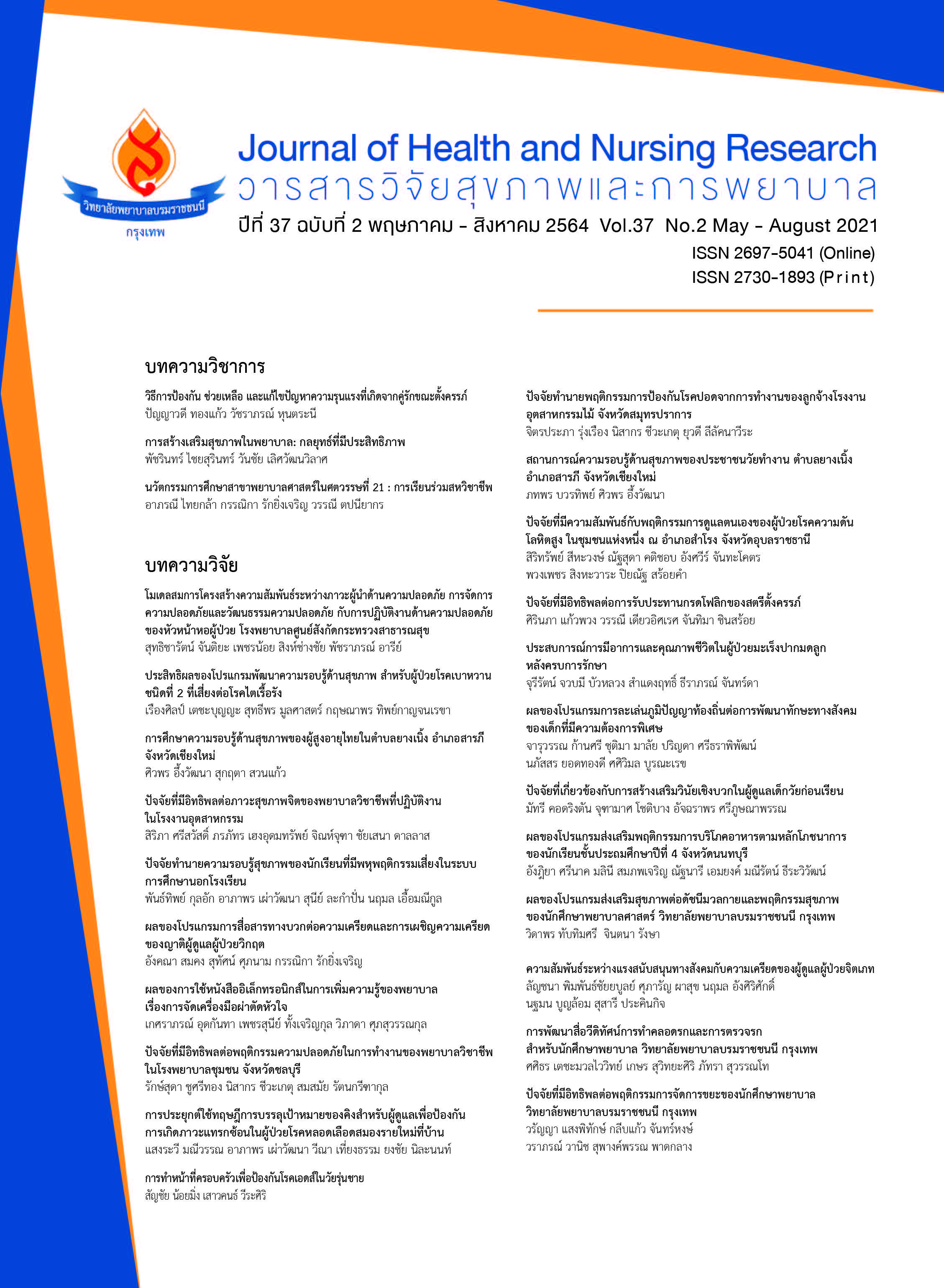นวัตกรรมการศึกษาสาขาพยาบาลศาสตร์ในศตวรรษที่ 21 : การเรียนร่วมสหวิชาชีพ
คำสำคัญ:
การเรียนรู้ในศตวรรษที่ 21, นวัตกรรมการศึกษาสาขาพยาบาลศาสตร์, การเรียนร่วมสหวิชาชีพบทคัดย่อ
บทนำ: ในยุคศตวรรษที่ 21 โลกมีการเปลี่ยนแปลงอย่างรวดเร็ว ส่งผลต่อวิถีการดำเนินชีวิต ซึ่งทำให้สภาพแวดล้อมทางสุขภาพ และความเจ็บป่วยของประชาชนมีความซับซ้อนมากขึ้น บุคลากรทางด้านสาธารณสุขจึงมีความจำเป็นต้องได้รับการเสริมสร้างให้มีสมรรถนะในการบริการสุขภาพแบบบูรณาการร่วมกัน วัตถุประสงค์: เพื่อนำเสนอการเรียนรู้สาขาพยาบาลศาสตร์ในศตวรรษที่ 21 ความสำคัญของการเรียนร่วมสหวิชาชีพ ขั้นตอนการนำรูปแบบการเรียนร่วมสหวิชาชีพไปปฏิบัติ และผลลัพธ์การเรียนรู้ของกิจกรรมการเรียนร่วมสหวิชาชีพ ประเด็นสำคัญ: บทความนี้กล่าวถึง การศึกษาสาขาพยาบาลศาสตร์ในยุคศตวรรษที่ 21 ที่มีการปรับเปลี่ยนรูปแบบการเรียนการสอนจากเดิม แบบเน้นการเรียนรู้เฉพาะวิชาชีพของตนเอง เป็นวิธีการเรียนรู้ให้ครอบคลุมการทำงานร่วมกันระหว่างสหวิชาชีพ เรียกว่า “การเรียนร่วมสหสาขาวิชาชีพ” รวมทั้งความสำคัญ ขั้นตอน และผลลัพธ์การเรียนรู้ของกิจกรรมการเรียนร่วมสหวิชาชีพของนักศึกษาพยาบาล สรุป: การเรียนร่วมสหวิชาชีพ เป็นนวัตกรรมทางการศึกษาพยาบาล เพื่อหวังผลลัพธ์การเรียนรู้ ให้นักศึกษาพยาบาลมีความรู้ความสามารถ และเกิดประสบการณ์ด้านการเรียนรู้ร่วมกันระหว่างสหวิชาชีพ โดยมีกระบวนการดำเนินงานให้มีประสิทธิภาพ 6 ขั้นตอน ทำให้เกิดผลลัพธ์การเรียนรู้ต่อผู้เรียน 6 ด้าน ข้อเสนอแนะ: สถาบันการศึกษาพยาบาล สามารถนำรูปแบบการเรียนร่วมสหวิชาชีพ ไปพิจารณาใช้จัดการศึกษาในหลักสูตรพยาบาลศาสตร์ได้ เพื่อให้นักศึกษาพยาบาลบรรลุผลลัพธ์การเรียนรู้ตาม ที่คาดหวัง
Downloads
เอกสารอ้างอิง
Saraketrin A, Rongmuang D, Chantra R. Nursing Education in the 21st Century: Competencies and Roles of Nursing Instructors. JRTAN 2020;20(1):12-20. (in Thai).
World Health Organization. Framework for Action on Interprofessional Education & Collaborative Practice. Health Professions Networks Nursing & Midwifery Human Resources for Health, Diana Hopkins, Freelance Editor, Geneva Switzerland (Editor). 2010 (cited 2021 Jan 15):9-11. Available from: http://www.who.int/hrh/resources/ framework action/en/index.html
Brandt B, Lutfiyya NM, King J, Chioreso C. A Scoping Review of Interprofessional Collaborative Practice and Education Using the Lens of the Triple Aim. JINCFT 2014;28(5):393-99.
Tanglakmankhong K, Khammathit A, Thammawongsa N, Ardpara A. The Effectiveness of the Nursing Innovation Course using Transprofessional Education Approach on Readiness for Transprofessional Skill and the 21st Century Skill. SCNJ 2019;6(2):126-39. (in Thai)
Kunaviktikul W. Teaching and Learning in the discipline of nursing in the 21st century. JTNMC 2015;42(2):152-6. (in Thai)
Bellanca J, Brendt R. 21st Century skills : Rethinking how students learn. 1st ed. Bloomington:Solution Tree Press; 2010.
Partnership for 21st Century Skill. Framework for 21st Century learning. 2011 (Cited 2020 Nov 21). Available from: https://www.21st centuryskills.org/p21org/our3work/p21framwork.
Trilling B. Fadel C. 21st Century Skills: Learning for life in our times. San Francisco, CA: Jossey-Bass; 2012.
Kaewmanee C. 21st Century Skills: Learning for life in our times. San Francisco, CA: Jossey-Bass; 2012.
Prajankett O. Transformative learning: Nursing education perspective. JRTAN 2014;15(3):182-183. (in thai)
Panich V. Transformative learning. Bangkok: S. R. Printing Massproduct Co, Ltd.; 2015. (in Thai)
Watanapa P. Health education for the 21st century: From concept to practice. Handout for the conference on Dean and Director of nursing institute “Nursing education managemarnt for the 21st century”; 2014 feb13;Amari Don Muang Airport Bangkok; 2014. (in Thai)
National Health Professional Education Foundation, Subcommittee of Interprofessional Education. Interprofessional Education (IPE). Editor: Chanuttha Ployleamsang. 2020 (Cited 2020 Nov 21). Available from: https://www.he01.tci-thaijo.org
Ploylearmsang C, Seehanart C, Chaiyatham D. Outcomes and Benefits of Interprofessional Education. IJPS 2020;16(3):1-14.(in Thai)
Kitreerawutiwong K, Kitreerawutiwong N. Implementing of Interprofessional Education into Health Professional Education. NJPH 2020;30(3):23-34. (in Thai).
Wilhelmsson M, Pelling S, Uhlin L, Owe Dahlgren L, Forslund K. How to think about interprofessional competence: a metacognitive model. Journal of Interprofessional Care 2012(26):2. (Cited 2021 April 9). Available from: https://doi.org/10.3109/13561820.2011.644644
Lllingworth P. Chelvanayagam S. Benefits of interprofessional education. BJN 2017; 813-18.
Stull CL, Blue CM. Examining the influence of professional identity formation on the attitudes of students towards interprofessional collaboration. JINCFT2016;30(1):90-96.
El-Awaisi A, Anderson E, Barr H, Wilby KJ, Wilbur K, Bainbridge L. Important steps for introducing
interprofessional education into health professional education. J. Taibah Univ. Medical Sci. 2016;11(6):546-51.
ดาวน์โหลด
เผยแพร่แล้ว
รูปแบบการอ้างอิง
ฉบับ
ประเภทบทความ
สัญญาอนุญาต
บทความที่ได้รับการตีพิมพ์ เป็นลิขสิทธิ์ของวารสารวิจัยสุขภาพและการพยาบาล (วิทยาลัยพยาบาลบรมราชชนนี กรุงเทพ) ไม่สามารถนำไปตีพิมพ์ซ้ำในวารสารฉบับอื่น


















